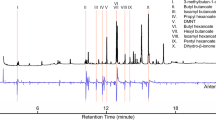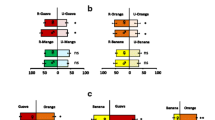Abstract
Solid-phase microextraction (SPME) and gas chromatography coupled with electroantennographic detection (GC-EAD) were used to identify a new blend of volatiles from apples as the key attractants for the apple maggot fly, Rhagoletis pomonella (Walsh). The new five-component blend contains butyl butanoate (10%), propyl hexanoate (4%), butyl hexanoate (37%), hexyl butanoate (44%), and pentyl hexanoate (5%) compared with a previously reported seven-component mix of hexyl acetate (35%), (E)-2-hexen-1-yl acetate (2%), butyl 2-methylbutanoate (8%), propyl hexanoate (12%), hexyl propanoate (5%), butyl hexanoate (28%), and hexyl butanoate (10%). Volatiles from five different varieties of apple elicited reproducible and high EAD responses from R. pomonella antennae to the same five chemicals. In flight-tunnel choice tests involving red sticky spheres with odor sources, the new five-component blend of apple volatiles showed significantly more activity than the previous seven-component blend or the single compound, butyl hexanoate. In a field trial captures with the new five-component blend were better than with butyl hexanoate, which is currently used with commercial apple maggot monitoring spheres.
Similar content being viewed by others
REFERENCES
Agelopoulos, N. G., and Pickett, J. A. 1998. Headspace analysis in chemical ecology: Effects of different sampling methods on ratios of volatile compounds present in headspace samples. J. Chem. Ecol. 24:1161-1172.
Aluja, M., and Prokopy, R. J. 1992. Host search behavior by Rhagloletis pomonella flies: Intertree movement patterns in response to wind-borne fruit volatiles under field conditions. Physiol. Entomol. 17:1-8.
Aluja, M., and Prokopy, R. J. 1993. Host odor and visual stimulus interaction during intratree host finding behavior of Rhagoletis pomonella flies. J. Chem. Ecol. 19:2671-2696.
Aluja, M., Prokopy, R. J., Buonaccorsi, J. P., and CardÉ, R. T. 1993. Wind tunnel assays of olfactory responses of female Rhagoletis pomonella flies to apple volatiles: Effect of wind speed and odor release rate. Entomol. Exp. Appl. 68:99-108.
Averill, A. L., Reissig, W. H., and Roelofs, W. L. 1988. Specificity of olfactory responses in the tephritid fruit fly, Rhagoletis pomonella. Entomol. Exp. Appl. 47:211-222.
Bartelt, J. R. 1997. Calibration of a commercial solid-phase microextraction device for measuring headspace concentrations of organic volatile. Anal. Chem. 69:364-372.
Berlocher, S. H., McPheron, B. A., Feder, J. L., and Bush, G. L. 1993. Genetic differentiation at allozyme loci in the Rhagoletis pomonella species complex. Ann. Entomol. Soc. Am. 86:716-727.
Bush, G. L. 1993. Host race formation and sympatric speciation in Rhagoletis fruit flies. Psyche 99:335-357.
Bush, G. L. 1994. Sympatric speciation in animals: New wine in old bottles. Trends Evol. Ecol. 9:285-288.
Carle, S. A., Averill, A. L., Rule, G. S., Reissig, W. H., and Roelofs, W. L. 1987. Variation in host fruit volatiles attractive to the apple maggot fly, Rhagoletis pomonella. J. Chem. Ecol. 13:795-805.
Chapman, P. J., and Lienk, S. E. 1971. Tortricid Fauna of Apple in New York. Special Publication, New York State Agricultural Experiment Station. 122 pp.
Feder, J. L., and Bush, G. L. 1989. A field test of differential host-plant usage between two sibling species of Rhagoletis pomonella fruit flies and its consequences for sympatric models of speciation. Evolution 43:1813-1819.
Feder, J. L., Chilcote, C. A., and Bush, G. L. 1989. Are the apple maggot, Rhagoletis pomonella, and the blueberry maggot, R. mendax, distinct species? Implications for sympatric speciation. Entomol. Exp. Appl. 51:113-123.
Feder, J. L., Chilcote, C. A., and Bush, G. L. 1990. Geographic pattern of genetic differentiation between host associated populations of Rhagoletis pomonella in the eastern United States and Canada. Evolution 44:570-594.
Feder, J. L., Opp, S. B., Wlazlo, B., Reynolds, K., Go, W., and Spisak, S. 1994. Host fidelity is an effective premating barrier between sympatric races of the apple maggot fly. Proc. Natl. Acad. Sci. U.S.A. 91:7990-7994.
Fein, B. L., Reissig, W. H., and Roelofs, W. L. 1982. Identification of apple volatiles attractive to the apple maggot. J. Chem. Ecol. 8:1473-1487.
Fletcher, B., and Prokopy, R. J. 1991. Host location and oviposition in tephritid fruit flies, pp. 139-171, in W. J. Bailey and J. Ridsdill-Smith (eds.). Reproductive Behavior of Insects. Chapman and Hall, New York.
Frey, J. E., and Bush, G. L. 1990. Rhagoletis sibling species and host races differ in host odor recognition. Entomol. Exp. Appl. 57:123-131.
Glover, T. J., Tang, X.-H., and Roelofs, W. L. 1987. Sex pheromone blend discrimination by male moths from the E and Z strains of European corn borer. J. Chem. Ecol. 13:143-151.
Green, T. A., Prokopy, R. J., and Hosmer, D. W. 1994. Distance of response to host tree models by female apple maggot flies, Rhagoletis pomonella: Interaction of visual and olfactory stimuli. J. Chem. Ecol. 20:2393-2413.
Matich, A. J., Rowan, D. D., and Banks, N. H. 1996. Solid phase microextraction for quantitative headspace sampling of apple volatiles. Anal. Chem. 68:4114-4118.
McPheron, B. A., Smith, D. C., and Berlocher, S. H. 1988. Genetic differences between Rhagoletis pomonella host races. Nature 336:64-66.
Neilson, W. T. A., and McAllen, J. W. 1965. Artificial diets for the apple maggot. III. Improved, defined diets. J. Econ. Entomol. 58:542-543.
Prokopy, R. J., Moericke, V., and Bush, G. L. 1973. Attraction of apple maggot flies to odor of apples. Environ. Entomol. 2:743-749.
Reissig, W. H., Fein, B. L., and Roelofs, W. L. 1982. Field tests of synthetic apple volatiles as apple maggot attractants. Environ. Entomol. 11:1294-1298.
Smith, J. J., and Bush, G. L. 1997. Phylogeny of the genus Rhagoletis inferred from DNA sequences of mitochondrial cytochrome oxidase II. Mol. Phylogenet. Evol. 7:33-43.
Zhang, A., Robbins, P. S., Leal, W. S., Linn, C. E. J., Villani, M. G., and Roelofs, W. L. 1997. Essential amino acid methyl esters: major sex pheromone components of the cranberry white grub, Phyllophaga anxia (Coleoptera: Scarabaeidae). J. Chem. Ecol. 23:231-245.
Author information
Authors and Affiliations
Rights and permissions
About this article
Cite this article
Zhang, A., Linn, C., Wright, S. et al. Identification of a New Blend of Apple Volatiles Attractive to the Apple Maggot, Rhagoletis pomonella . J Chem Ecol 25, 1221–1232 (1999). https://doi.org/10.1023/A:1020910305873
Issue Date:
DOI: https://doi.org/10.1023/A:1020910305873




